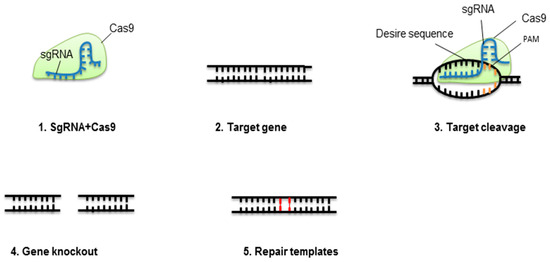1000/1000
Hot
Most Recent

The genome-editing tool, CRISPR-Cas9, reveals the functional features of several parts of the plant genome. Current developments in CRISPR, such as de novo meristem induction genome-engineering in dicots and temperature-tolerant LbCas12a/CRISPR, enable greater DNA insertion precision.
In cells, CRISPR-Cas9 is a cheap, easy, fast, and effective system for gene knockout[1]. For effective genome engineering, CRISPR-Cas9 has been used in animals, plants, and bacteria[2][3][4][5]. Furthermore, CRISPR-Cas9 has been used for high-throughput screening of genes, gene knockout, chromosomal loci live-cell labeling, endogenous gene expression, and single-stranded RNA (ssRNA) edition. The application of CRISPR-Cas9 for studying the function of a gene has generated disease models. However, several queries and challenges need to be addressed. CRISPR-Cas9 will likely enhance our comprehension of disease activity and its management. For targeted genome engineering, detecting programmable nucleases that produce cuts in double-strands has radically changed molecular biology; ZFNs pioneered this success, with TALEN extending the genome modifying capacity[6]. Globally, CRISPR-Cas9 received recognition from researchers for its visible benefits over TALEN and ZFN[7], being its (1) ease of designing target, (2) ability to create mutations by inserting the guided RNA and Cas9 protein, and (3) multiplexing ability to target several genes at one time [8][9]. Figure 1 summarizes the principles of CRISPR-Cas9.

Figure 1. Concept of CRISPR-Cas9-mediated gene elimination. Single guide RNA (sgRNA) containing crRNA and tracrRNA fixes to Cas9 protein. This complex will break at a specific target of the double-stranded DNA molecule. The nonhomologous end-joining pathway (NHEJ) will repair the cleaved location.
Due to its robust success, CRISPR-Cas9 is becoming a potential tool for genetically enhancing desirable crop traits, i.e., disease resistance, nutrient content, adaptation to multiple stresses, plant architecture, and yield. In some cases, a specific trait can be improved by negative regulatory gene knockout. Rice grain weight improved with gene modification of some QTL[10]. Maize grain yield under drought increased with genome engineering of the ARGOS8 locus[11]. In woody plants, CRISPR-Cas9 produced mutants in the first transgenic generation; this is significant as woody plant breeding is difficult due to their long lifespan[12][13]. Another study knocked out the OsGAN1 gene in rice and verified that it regulates root length and plant height[14]. Similarly, OsABCG26 gene knockout verified that this gene regulates pollen exine and anther cuticle, and OsTCD10 had a substantial role in chloroplasts of cold-stressed rice[15][16].
Genome editing by CRISPR-Cas9 has been used effectively in several crops, including cotton, maize, rice, and wheat. However, most genome engineering studies have targeted biotic stresses, such as diseases. In wheat, the CRISPR-Cas9 method was used successfully to knock out all three EDR1 homologs to create plants (Taedr1) with increased tolerance to powdery mildew [17]. In Arabidopsis, the knockout of susceptible gene EDR1 increased resistance to powdery mildew[18]. Recessive resistance genes, eIF (eukaryotic translation initiation factor), have been detected in several dissimilar hosts, with eIF (iso) 4E and eIF4E genes used with CRISPR-Cas9 to form virus-resistant plants in Arabidopsis and cucumber, respectively[19][20]. CsLOB1 is a susceptible gene of the citrus canker (causative agent; Xanthomonascitri); CRISPR-Cas9 was used to edit this gene to develop resistant grapefruit plants [21][22]. Additionally, a negative resistance function MLO gene, responsible for powdery mildew susceptibility, was mutated successfully by Cas9 knockouts to enhance resistance against powdery mildew in tomato and wheat [23][24][25]. The application of CRISPR-Cas9 as an antivirus tool cleaved beet severe curly top virus, which decreased the viral infection[26][27]. The rice tungro spherical virus (RTSV), linked to the negatively controlled susceptible eIF4G gene, was eliminated using CRISPR-Cas9 to develop resistant rice varieties[28]. From CRISPR-Cas9, the loss of function VvWRKY52 gene produced resistance against Botrytis cinerea in grape (Vitis vinifera)[29]. Furthermore, CRISPR-Cas9 has been used to interrupt multiple virus genomes, including CLCuK0V, TYLCSV, and TYLCV[30]. For cucumber mosaic virus and tobacco mosaic virus, a technology to modify RNA virus genomes has been advanced from sgRNA and FnCas9. Hence, molecular immunity to RNA viruses was mediated by sgRNA/FnCas9 expression in Arabidopsis and tobacco[31]. CRISPR-Cas9 successfully targeted OsERF922 against blast fungus resistance in rice[32]. Plant ethylene-responsive factors (ERFs) can control tolerance against various stresses because they are involved in the ethylene (cytokinin) pathway[33]. When taken together, these reports deliver robust indications that CRISPR-Cas9 can enhance biotic stress resistance in plants (Table 2).
Table 2. CRISPR-Cas9 application for crop improvement.
| Species | Traits | Target Genes | Reference |
|---|---|---|---|
| Abiotic stresses | |||
| Rice | Improved resistance to arsenic stress | ARM1 | [34] |
| Depletion of Cd into grain | LCT1 | [35] | |
| Depletion of Cd into grain | Nramp5 | [36] | |
| Drought tolerance | SAPK2 | [37] | |
| Tomato | Drought tolerance | SIMAPK3 | [58] |
| Maize | Drought tolerance | ARGOS8 | [39] |
| Arabidopsis | Cold tolerance | CBF1 CBF2 | [40] |
| Biotic stresses | |||
| Arabidopsis | Resistance to turnip mosaic virus | eIF (iso)4E | [20] |
| Wheat | Improved resistance to powdery mildew | TaMLO | [25] |
| Improved resistance to powdery mildew | EDR1 | [17] | |
| Rice | Increased resistance to blast fungus | OsERF922 | [32] |
| Increased resistance to tungro spherical virus | eIF4G | [28] | |
| Barley | Improved resistance to fungal pathogens | MORC1 | [41] |
| Orange | Improved resistance to citrus canker | CsLOB1 | [42] |
| Tomato | Improved resistance to powdery mildew | Mlo1 | [24] |
| Anthocyanin biosynthesis | ANT1 | [43] | |
| Grape | Improved resistance to Botrytis cinerea | WRKY52 | [29] |
| Cucumber | Virus resistance | eIF4E | [19] |